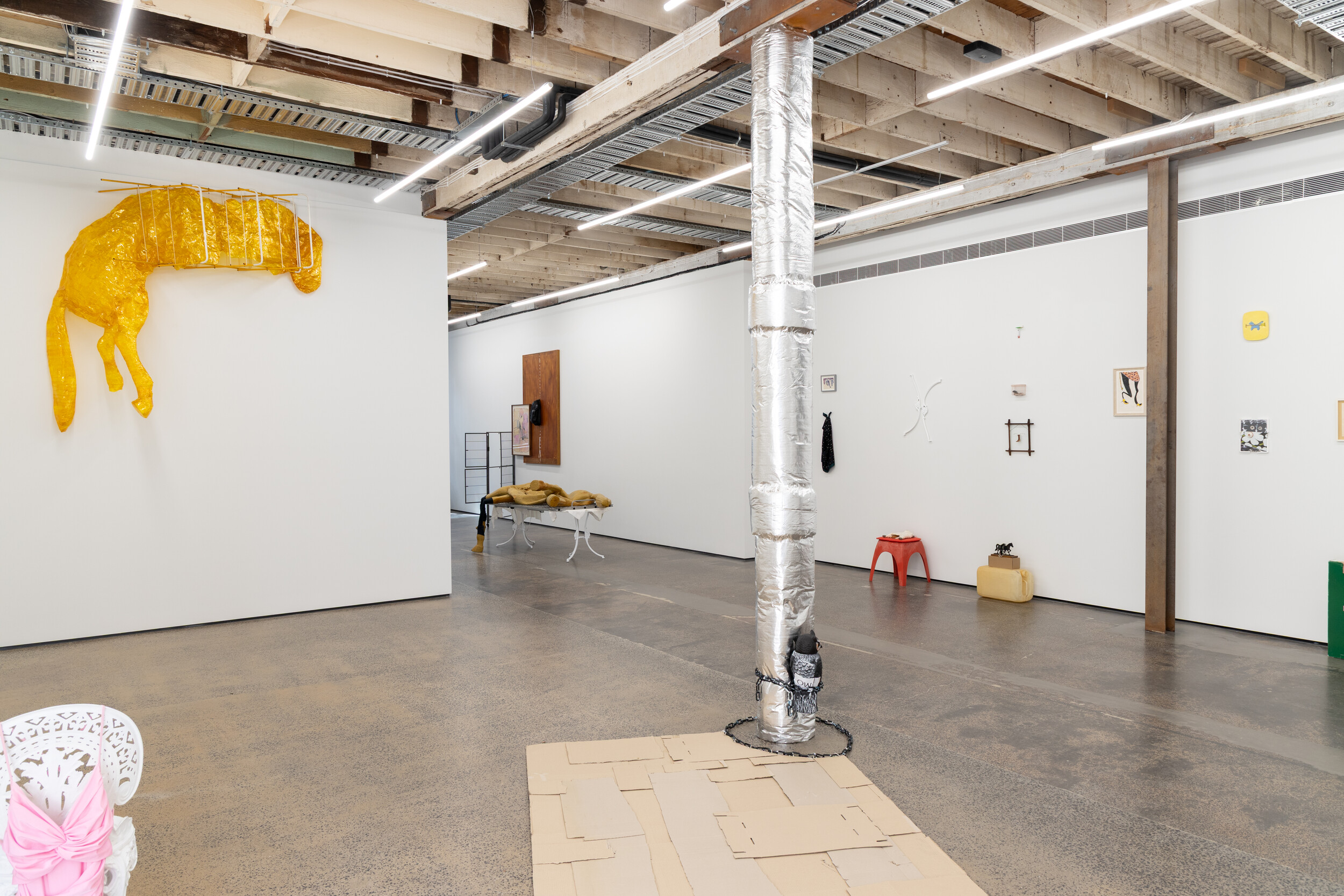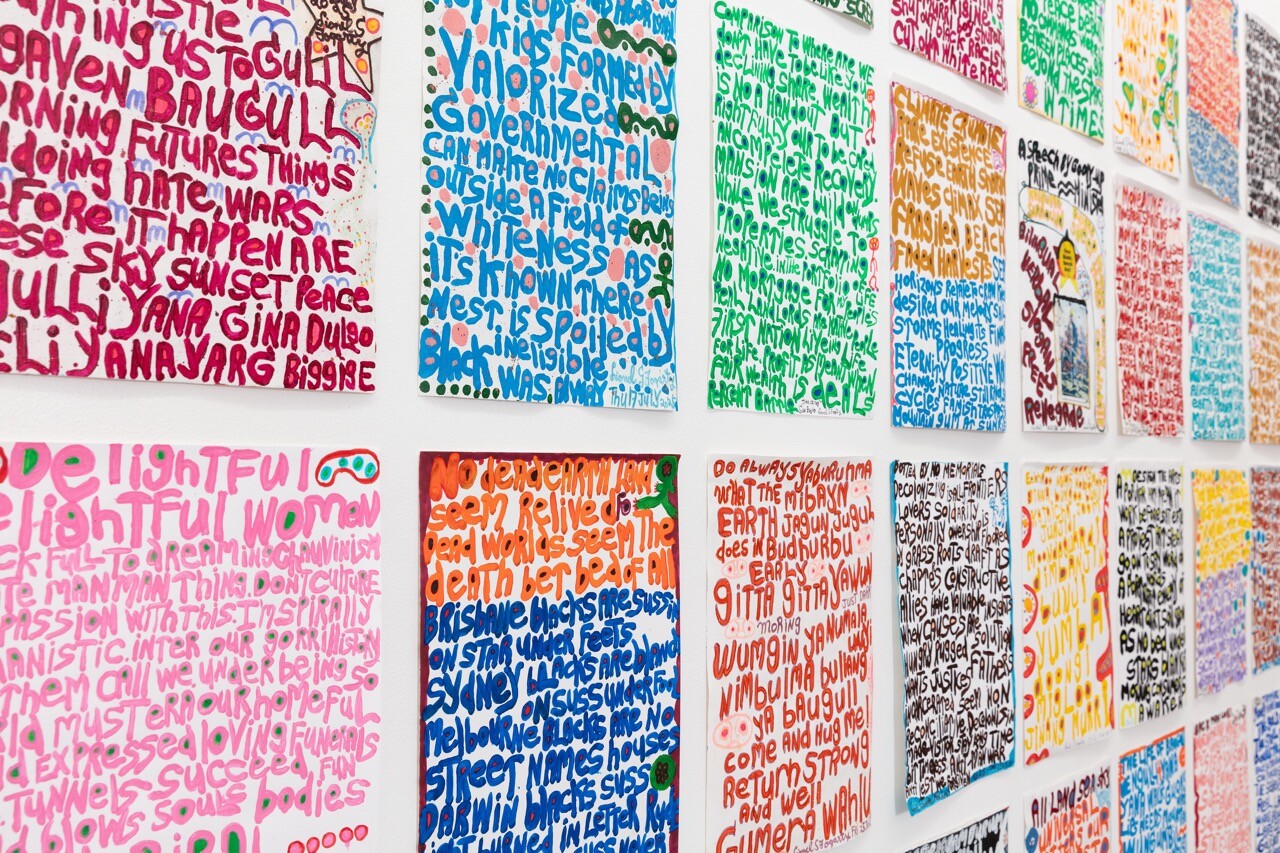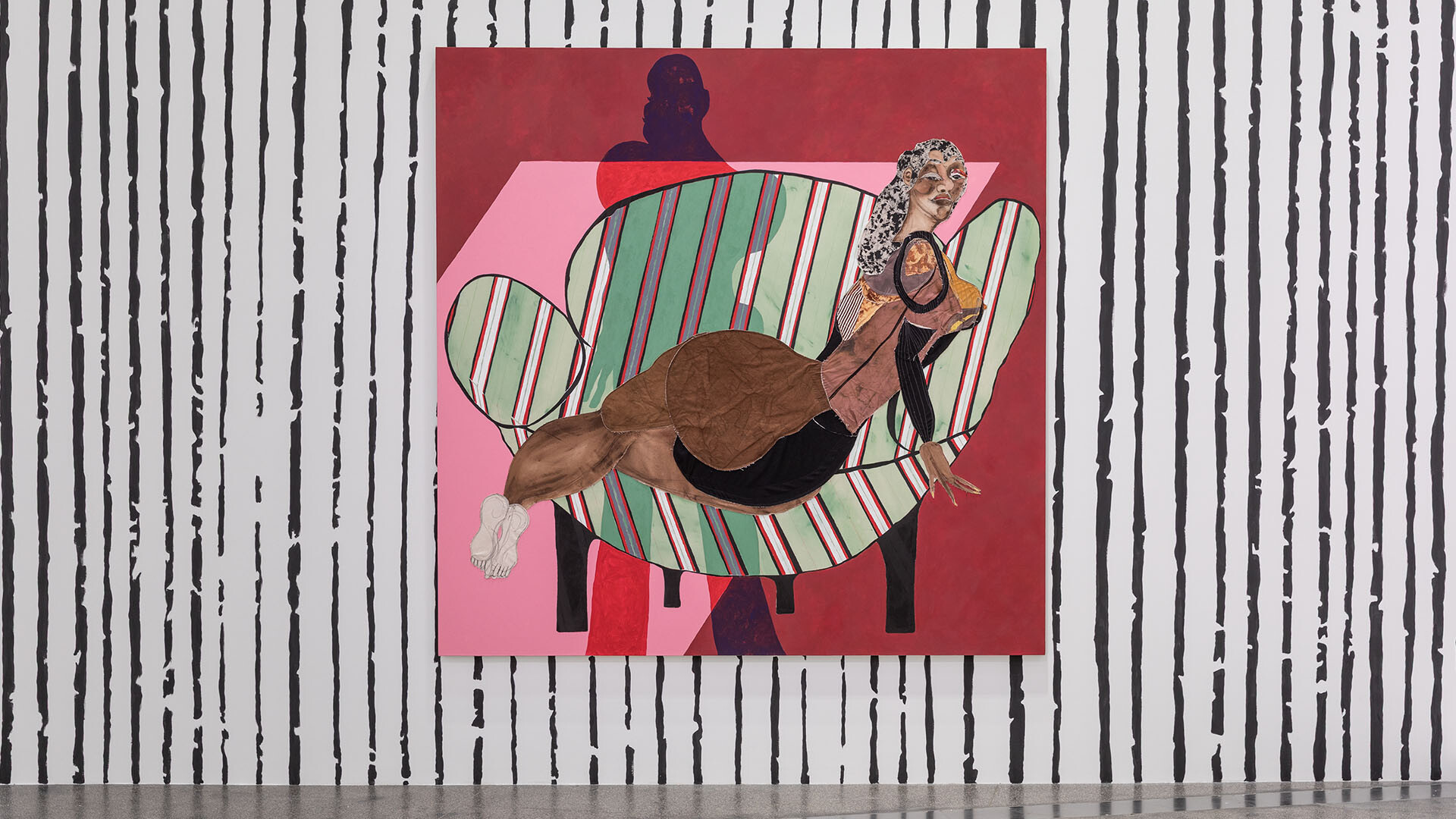Anna Varendorff, Adjacent Greys (detail), 2025. Mild steel, enamel paint, brass, sterling silver solder. 122 x 280.5 x 14.7 cm
Kiki; Spider with the Glass Legs
David Wlazlo
Have you ever developed a certain fondness for, or perhaps even an emotional attachment to, a disposable plastic bag? Sometimes, for example on holiday or in the kitchen, items that we are told are disposable can become vital to the day-to-day reckoning of storing food, wet clothes, keeping documents and artifacts safe, as well as tasks that go above and beyond humble material origins. Sometimes we also grow attached to fine-quality materials rescued, discovered, and hunted from markets and rubbish piles. This connection between people and material might appear strange to you, but it might also resonate with how you navigate your own life. Whichever side of this imaginary fence you find yourself on, the two artists I’m reviewing both have a unique, detailed, engaged, and personal approach to material. The artists—Anna Varendorff and Tamara Henderson—each have a show on at the Warrnambool Art Gallery that I made a short trip to see. I also never hesitate to visit Warrnambool to scour through the Fletcher Jones vintage market, on my own quest for material culture.
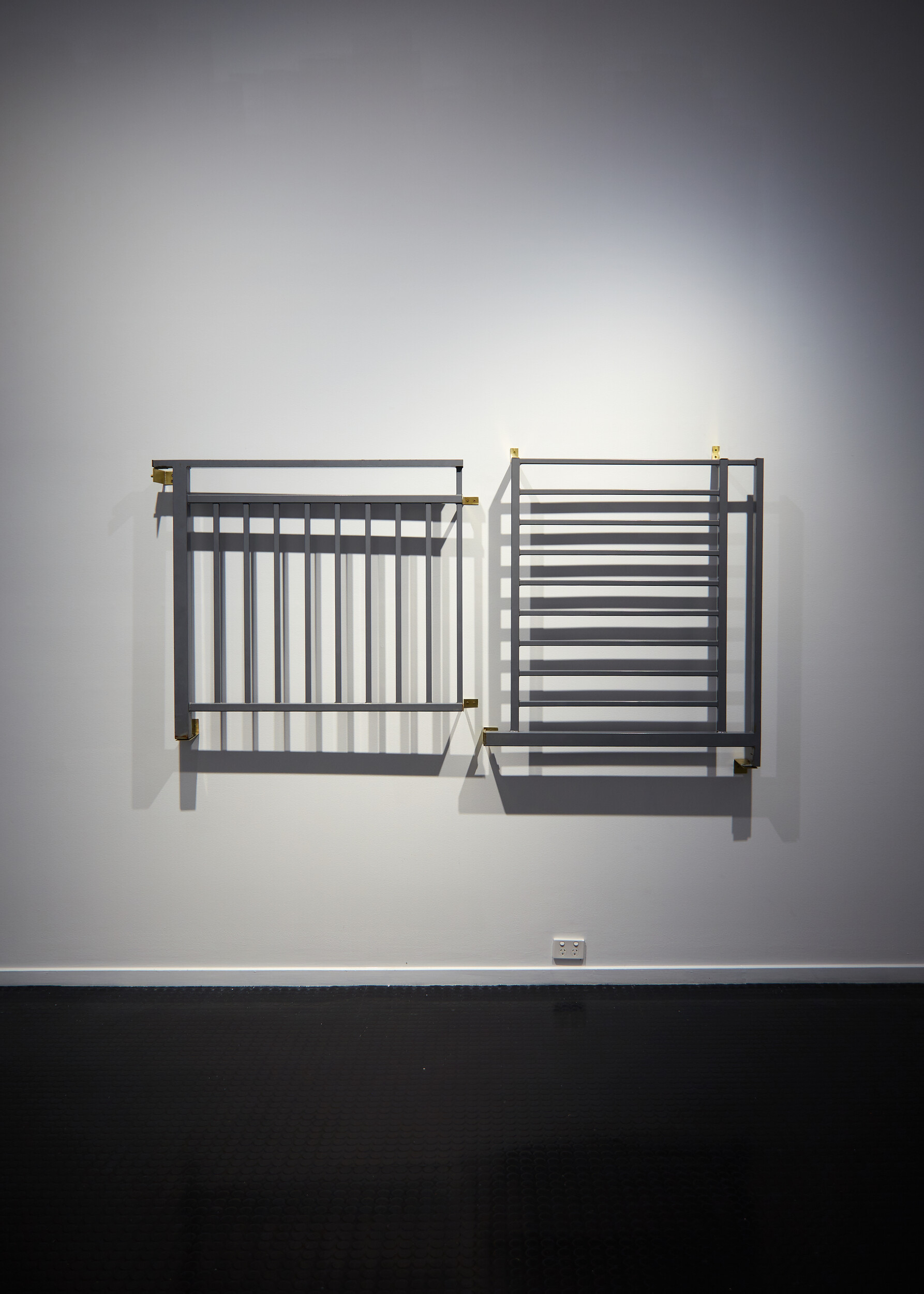
Anna Varendorff, Adjacent Greys, 2025. Mild steel, enamel paint, brass, sterling silver solder. 122 x 280.5 x 14.7 cm
Anna Varendorff’s exhibition kiki is out the back of—or perhaps deep within—the gallery. Through a large room showing works from the permanent collection, a smaller gallery space housing four works reveals itself. Industrially produced metal gates, welded mesh on extruded metal frames, and steel in planar form are arranged on the walls. These metal structures sit out between ten and twenty centimetres from the wall and are supported by brushed brass brackets and attaching mounts. Seemingly hand crafted, these mounts gently carry the steel structures. The gallery lighting casts intricate rhythmic shadows on the wall, echoing Varandorff’s steel structures and visually reinforcing the lines produced through construction and engineering.
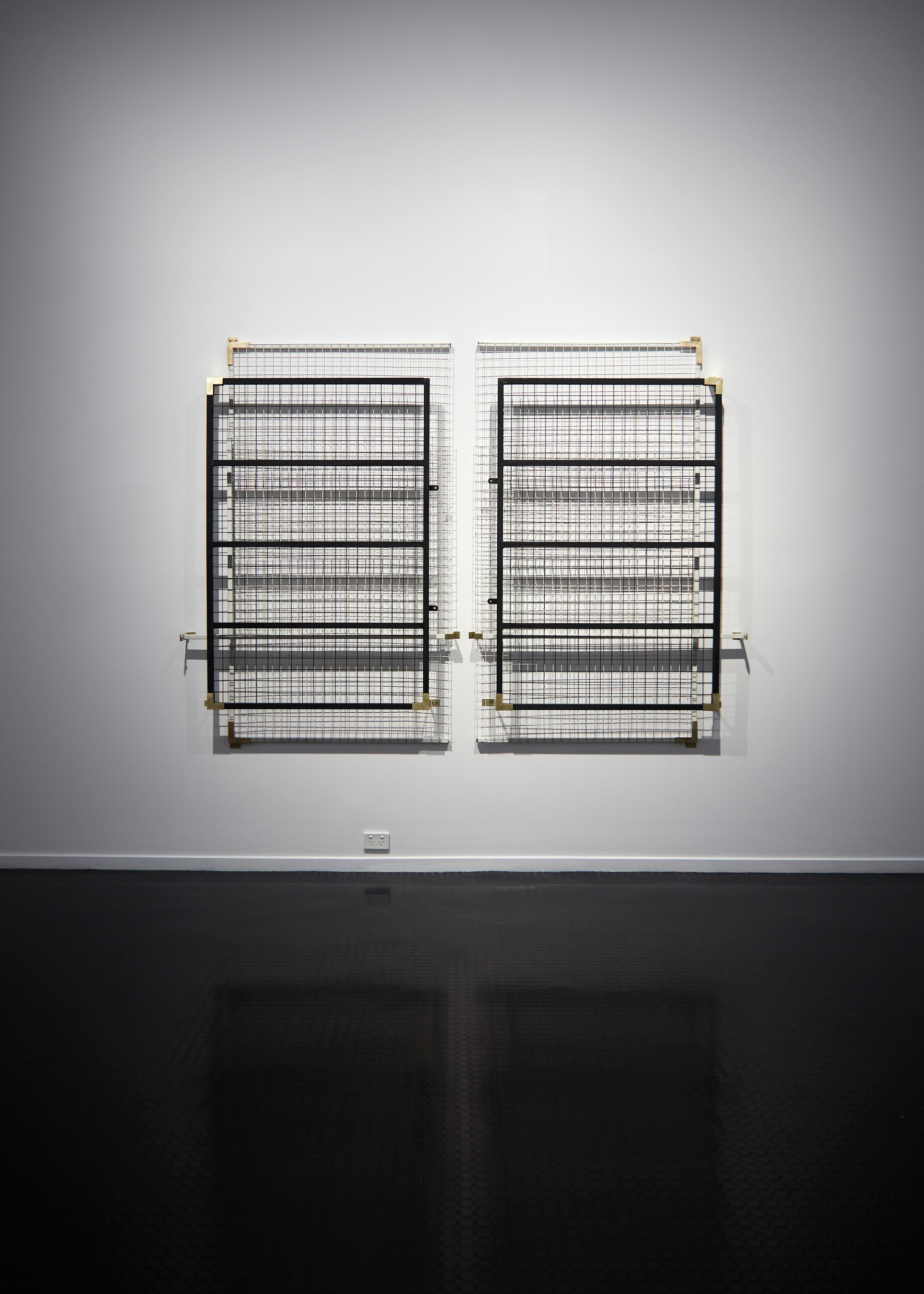
Anna Varendorff, Layers of Black and White, 2025, Mild steel, unknown metal paint, brass, sterling silver solder, 184 x 230 12 cm
The exhibition title, kiki, is a mystery at first glance. It’s not discussed in the didactics printed in whatever non-vintage form of Letraset they use these days. But it is answered in the last question of an interview published in the exhibition booklet, which was available in a different room to the artworks. The kiki of the title refers to something called the “Kiki/Bouba effect.” This effect relates to visual shapes and the way that humans across cultures and languages will generally associate the phonetic sound “bouba” with a rounded shape, while connecting the sound “kiki” with a sharp, angular shape. While Varendorff admits that the science might be shaky, this remark—almost made in passing in the interview—foregrounds the idea of natural language, biological sounds, perhaps even synaesthesia brought into relation with material and form. Why would people across cultures connect particular sounds to particular shapes? My uneducated guess is that our mouths mimic the shapes through sounding them out. But what shapes and sounds do these works evoke, if any?
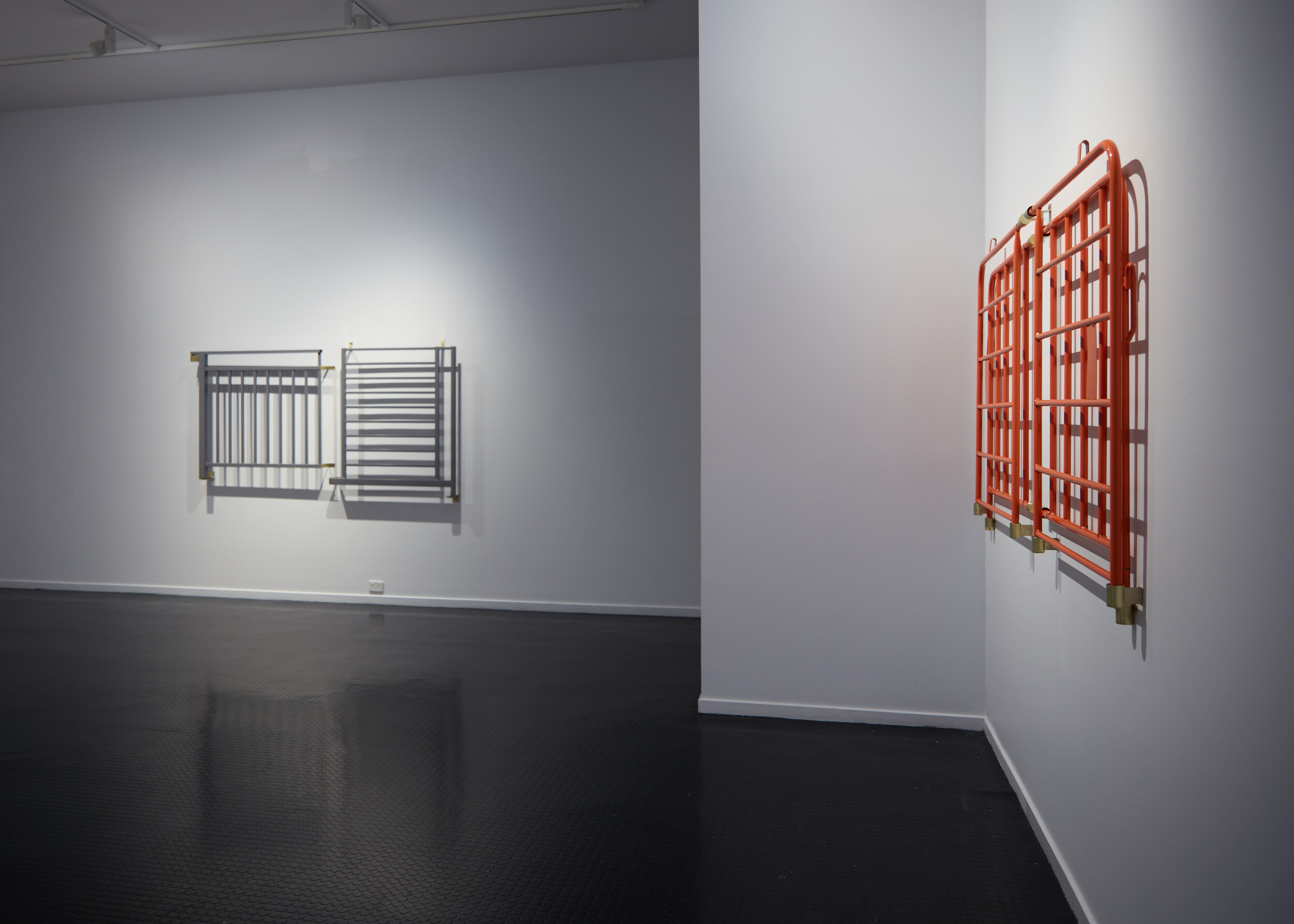
Installation view, Anna Varendorff kiki, 2025, The Warrnambool Art Gallery
Two Layers of Orange (2025) presents what appears to be the two halves of an orange gate. These metal parts mirror one other, and it is difficult to tell if there are four identical pieces of metal or two. The brass brackets holding them to the wall are gentle: they aren’t firmly attached to the gate by screw, bolt, or weld. Instead, they hold the gate in stasis against the wall as though in shirt cuffs or perhaps even hand cuffs, as if gates have hands. The orange painted surface of the metal is chipped and uneven, and one gets the impression that they were found this way. The two halves of the sculpture are set at right angles to one another, resulting in a grid-like, woven structure. The shadows that are produced echo and reinforce this structure, and the effect is of a sculpture-slash-painting produced as an image that is both flat and three-dimensional.
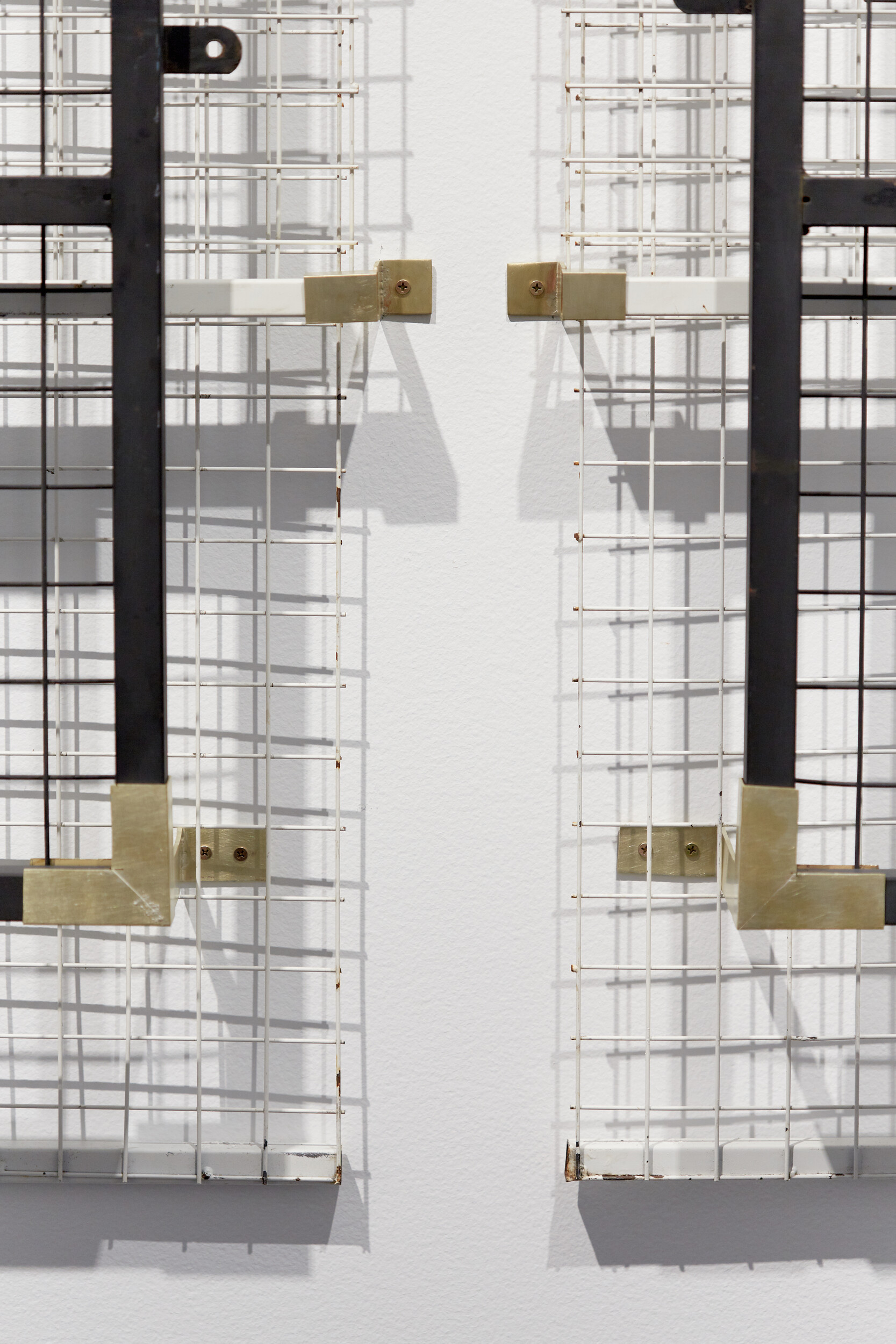
Anna Varendorff, Layers of Black and White (detail), 2025, Mild steel, unknown metal paint, brass, sterling silver solder, 184 x 230 12 cm
The other works in the exhibition appear to show the same concerns: the colours and industrial production of found flat metal objects are held away from the wall by delicate-seeming—or, at least, considered—brass mounting brackets. These brackets look to be Varendorff’s primary material intervention with these works, and the wall text describes them as forming part of her jewellery-making practice. Adjacent Greys (2025), for example, shows two solid metal gates arranged perpendicularly to one another (I hesitate to call one “the right way up”). The brass details sit well with the institutional grey. Black Frames (2025) juts out into the space, almost looking sharp and “kiki,” but the three other works are definitely wall-bound and quite strongly pictorial.
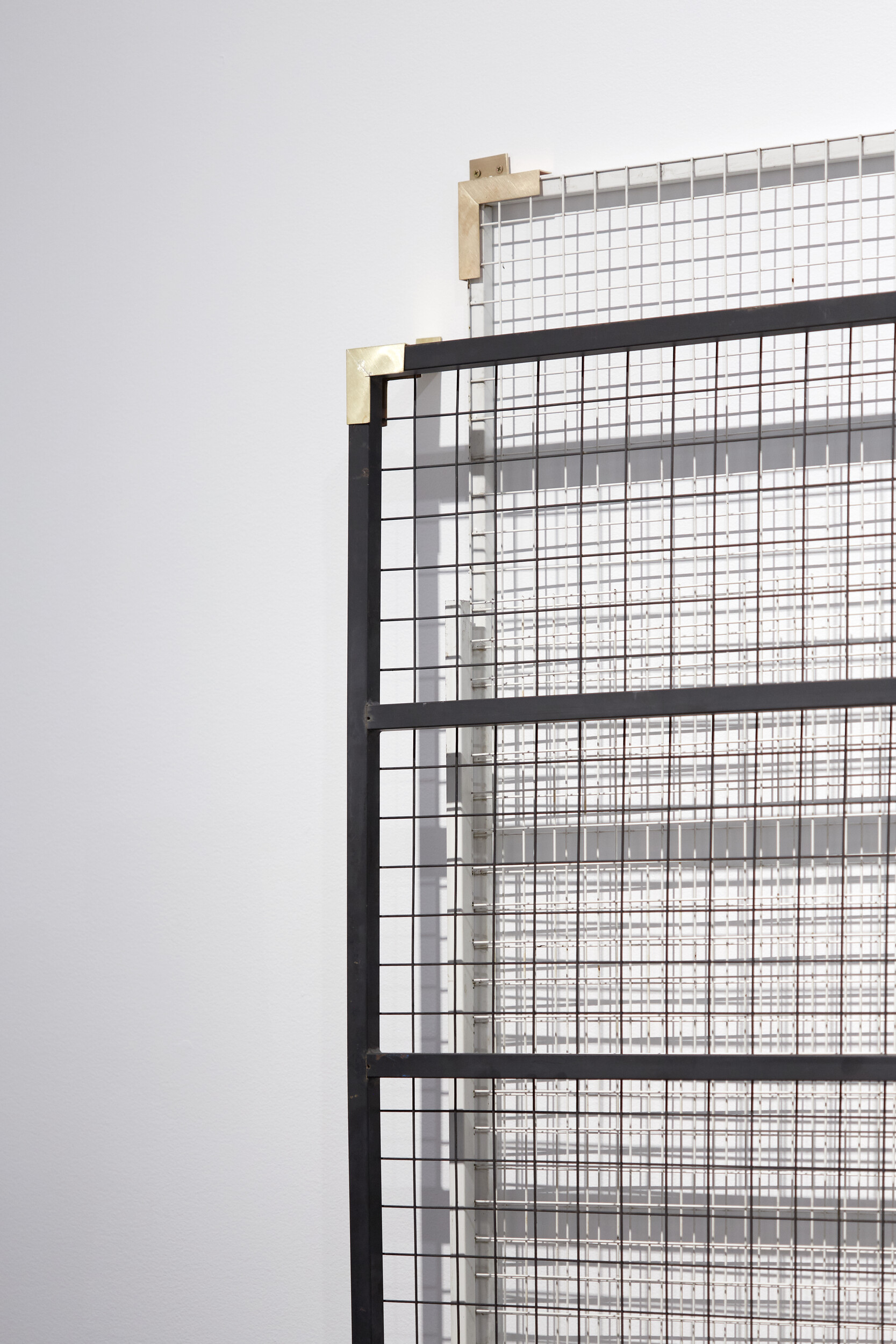
Anna Varendorff, Layers of Black and White (detail), 2025, Mild steel, unknown metal paint, brass, sterling silver solder, 184 x 230 12 cm
There are deep historical lineages connecting the aesthetic devices and tropes of these works to the gallery as institution and the art-historical establishment. The ready-made, for example, decontextualises industrial objects, giving them aesthetic or conceptual charge enough to be “art,” which is presumed to be either an upgrade for the object or a downgrade of art as a category. This argument hopefully doesn’t need to be recapitulated here, lest we all gouge our eyes out. There are also connections to the canonical arguments around Minimalism in the 1960s and onwards: when does a painting cease to be about flatness and when does a sculpture become something to be looked at from the “front”? When does the “internal/pictorial” complexity of an image simply echo the frame or support? There are also concerns rising out of these weighty historical references, such as the aesthetics and conceptualisation of presentation and framing: do the very pictorial shadows constitute the work as well, after we look through the weaving metal structures? Does this mean the works cast an image on the walls of the institution with a capital I? Do these works have internal pictorial complexity, or are they all frame?
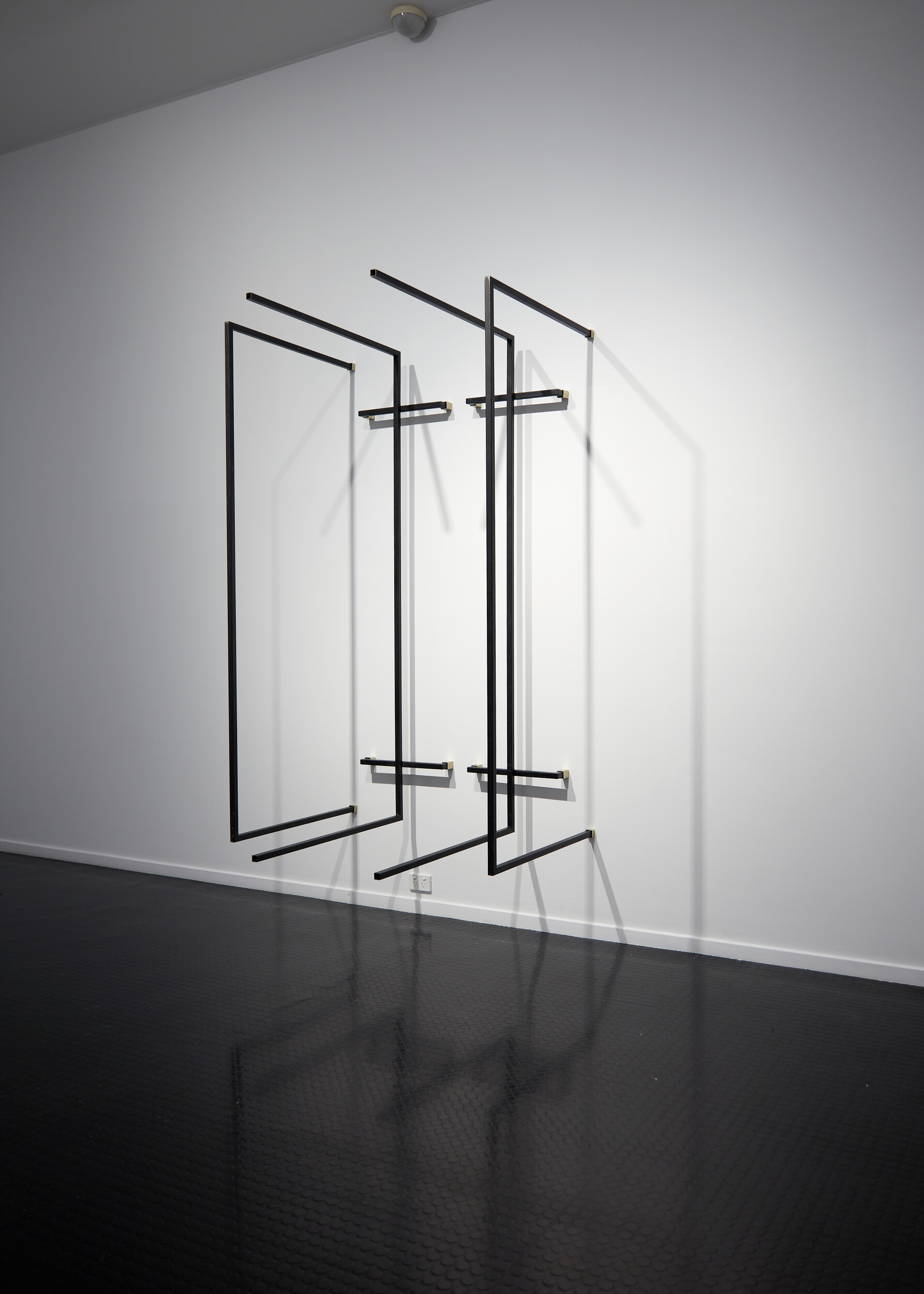
Anna Varendorff, Black Frames, 2025. Mild steel, water-based paint, brass, sterling silver solder. 210.7 x 126.3 x 128 cm
The ideas in Varendorff’s work here are all part of these weighty high-tensile threads embedded in history and academia. In the accompanying interview, the artist connects her work even further back into history. In discussion with curator Micky Schubert, Varendorff speaks of the Bauhaus as a key influence for her work. Perhaps surprisingly, she doesn’t speak of the exploration of extruded metal piping as the source of this connection (extruded steel being one of the cutting-edge materials exalted by modernist design movements). Rather, Varendorff describes in more general terms the distinction between different kinds of work: that of the artist and factory labourer. In contrast, perhaps, to the Bauhaus and its emphasis on a blurry distinction (workers as artists and artists as workers), Varendorff appears to retain this contrast, describing the distinction between factory work and artistic work as different economically and teleologically: they have different means and aims. I get it: a hundred years on and we’re all disillusioned. Perhaps, though, it is the aesthetic qualities of vintage steel construction that makes it hard to look through to a liberated factory worker/artist? Maybe the aesthetic weight of salvaged steel construction is too heavy to shift aside and see the agency of the worker who produced it? It could also be that recycled, repurposed, aestheticised and—perhaps—elevated metal construction is an aesthetic and a concern that looks back by default to a function that is presumed lost, maybe in some kind of socio-economic past that precedes our late-capitalist enshittification? You don’t need to tell me twice that vintage material and stuff is generally better. But, to be honest, what do we—of the post-industrial, service-economy—know about factory labour? The closest I ever got was scrambling through fences in the nineties, the odd rave, and browsing vintage markets on repurposed factory floors.
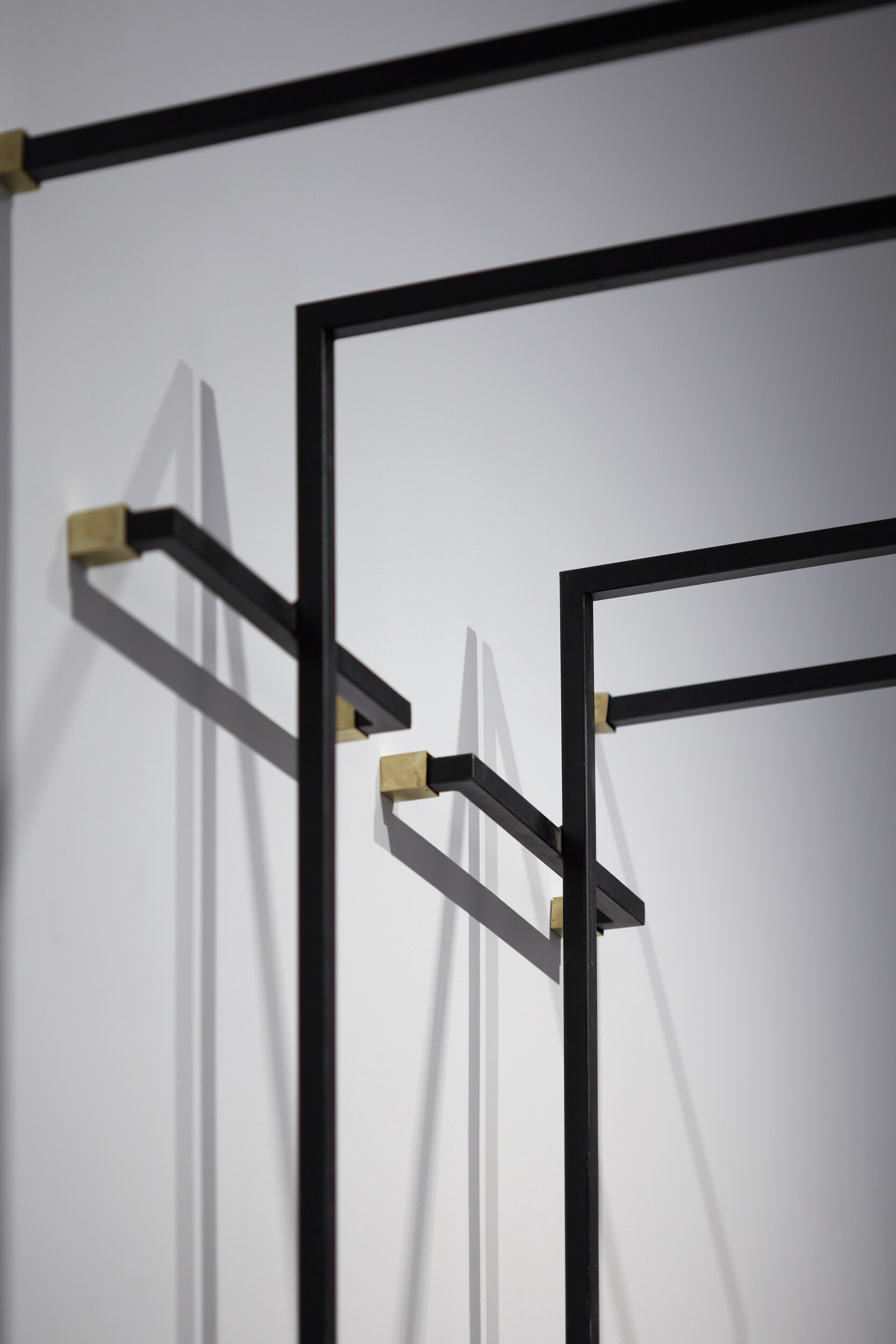
Anna Varendorff, Black Frames (detail), 2025. Mild steel, water-based paint, brass, sterling silver solder. 210.7 x 126.3 x 128 cm
Varendorff says that she’s “trying to re-value the salvaged materials,” which I can totally relate to. (Although, these pieces of metal could also have been thwarted from re-entering “useful,” non-artistic life—perhaps, after all, the delicate brass cuffs are in fact manacles that seize and restrain the metal against its will?) The matter of material is complicated by her further statement: “Metalwork is not a theme of my work, but handling metal has felt natural for me, and its properties engage with labour, which is a theme.” Perhaps division of labour, work, and economics as a layer of abstraction over the found metal here is key to understanding how Varendorff’s material intervention can be so slight, restrained, or even austere, when in her commentary she nevertheless talks about the work of the artist as purposive and expressive of authorship. I’m left wondering if feeling strongly about materials and making objects with intention is not enough in an art practice. If not, why not? Material relations are socio-economic relations, and these are all human relations, after all. Varendorff could have told me that she simply likes recycled metal constructions—leaving out the economic theory—and I still would have been in.
Varendorff continues by hopefully wondering “how these hard, sharp shapes might make people feel about my affection for them as material and if that translates to other people’s experience of them.” The Kiki, then, is the key: the artist has a deep affection for metalwork, feels natural around it, but nevertheless reaches out to the interconnectedness of economics and labour as a theme in order to test how this material connection might be received. The restrained, almost tentative, brushed brass wall mounts and Varandorff’s comments about connection bring me to see—behind all the thinking around labour and work—an almost hidden emotional drive in this presentation. I feel as though, after expressing her affection for and familiarity with these materials, Varendorff is really hesitant to develop this connection. Maybe I see an abundance of caution here because, to me, the line between artistic and other labour is more malleable. An artist can put jewellery on a gate just as much as a welder can value the aesthetic outcome of their work.
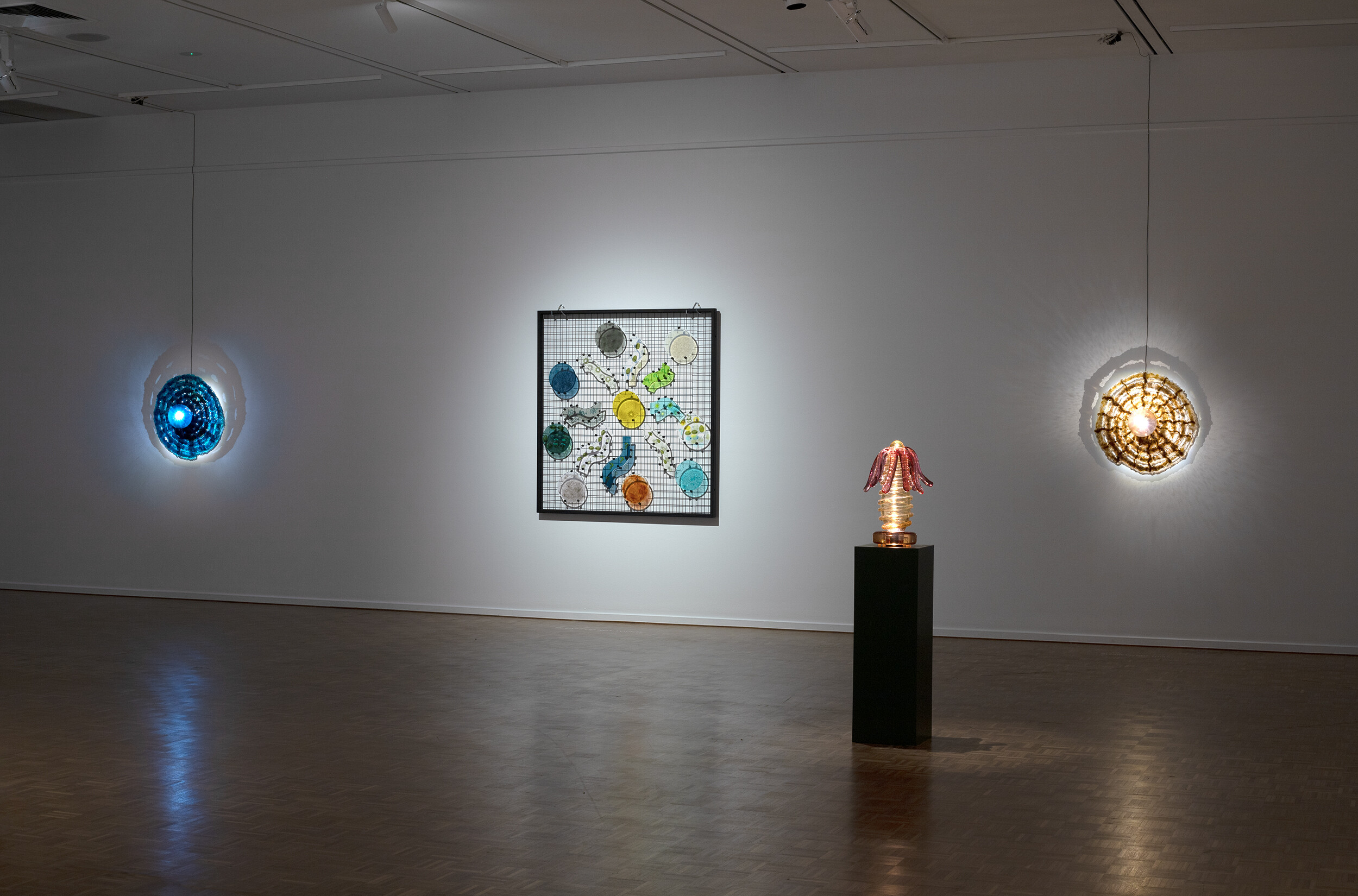
Installation view, Tamara Henderson Spider with the Glass Legs, 2025, The Warrnambool Art Gallery, photography David Keating
Tamara Henderson’s exhibition Spider with the Glass Legs opens the day I visit. In a large, darkened gallery, atmospheric music seeps through concealed speakers like the bubbling of a hidden cauldron. A series of glass platters, wall mounted with blown glass spheres—lit from the inside like multi-coloured areoli—are evenly placed around the room. Many of these glass designs have spider-like, axial, multi-limbed motifs. In between these lit forms on the wall are two abstract paintings showing tendril-like symmetrical forms, folded in on each other like close-up portraits of insect faces. These are framed by cryptic symbolism—eyes, snakes, eggs, suns, spirals—and each painting is placed directly across the room from the other. Similarly, but in the other direction, two wall-mounted arrangements of glass shapes—again, eyes, circles, suns, spider-like forms, question marks—face each other across the room, hinting at hidden meanings and mysterious symmetries.
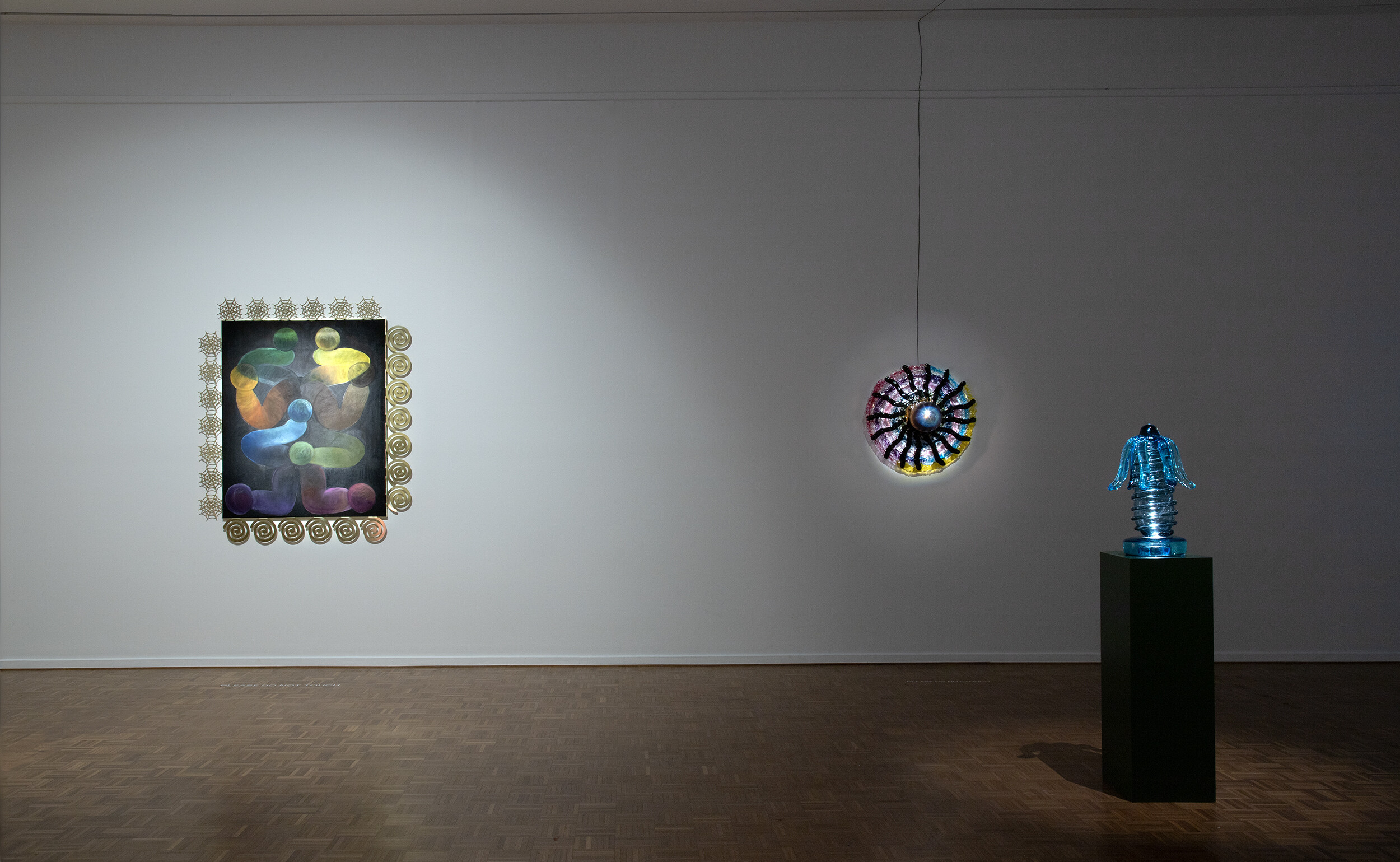
Four plinths stand evenly spaced around the gallery. Upon each, a blown glass lamp structure sits with eight drooping, tentacle-like limbs. Centred in this carefully arranged room is a large, eight-legged chair upholstered in green artificial fur. At the foot of each leg is a coloured, internally-lit glass sphere about twenty centimetres in diameter. The symmetries, the light and sound, the cryptic symbols, the oversized and elaborate chair, all create the atmosphere of this being the throne room of a cult leader or some latent power.
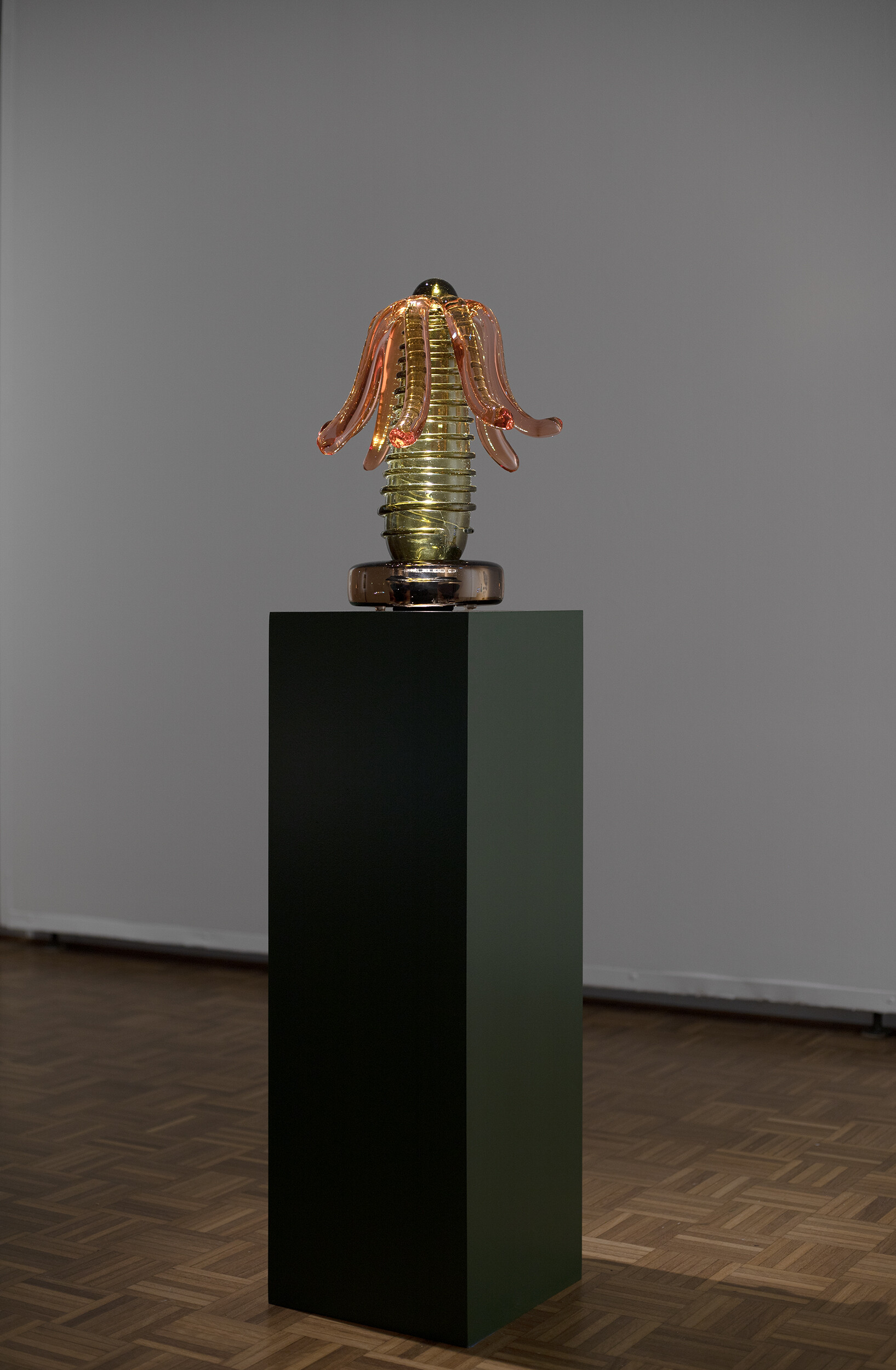
Installation view, Tamara Henderson Spider with the Glass Legs, 2025, The Warrnambool Art Gallery, photography David Keating
The evenly spaced artworks multiply their number: the two paintings, Wiseguide Painting (2025) and Sunspider Painting (2025), face off across the room, as do the two wall arrangements, Sunspider Shadow (2025) and Wiseguide Altar (2025). Four wall pieces, Web Wall Light Umber, Green, Black and Blue (2025), are matched by four floor pieces, all Floral Lamps (2025). Two becomes four, and four becomes eight. Eight becomes the legs of the Sunspider Chair (2025). These geometric and numerical relations are, according to Henderson, an organising principle. In an interview accompanying the show, Henderson states that “the Sunspider is an eight-limbed enlightened translator organising meaning and energy.” It’s amusing here to reflect on the dual meanings of enlightened and energy, as the work is both wired up electrically and emits light.
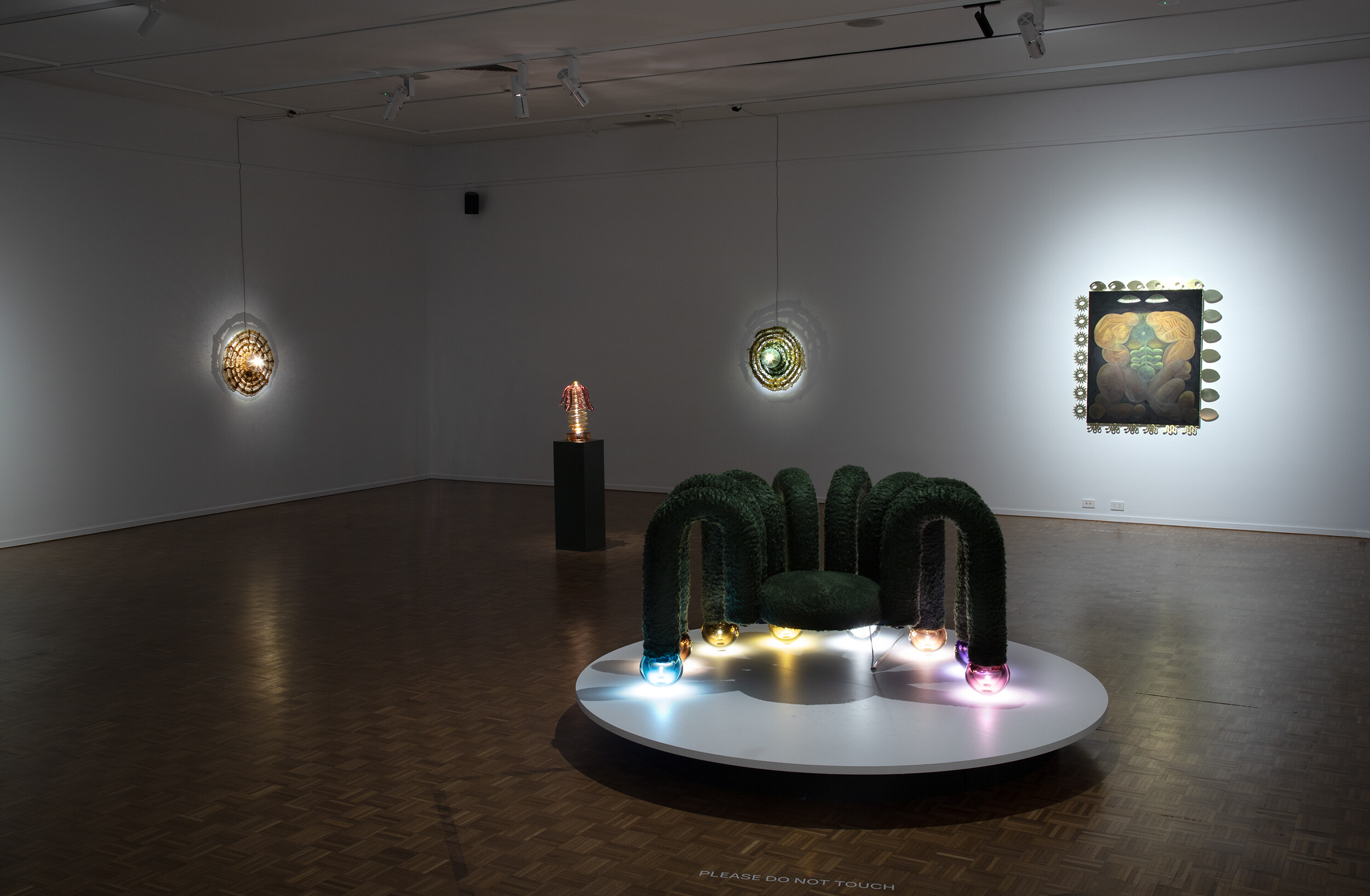
Installation view, Tamara Henderson Spider with the Glass Legs, 2025, The Warrnambool Art Gallery, photography David Keating
The show oozes a sense of light-hearted fun and mystery. It is like Henderson has decided to have a party, but has insisted on hand-making everything out of glass. The exhibition’s “aboutness” is, according to the interview, related to the artist’s ongoing practice: ideas for work percolate from one exhibition to the next, condensing and building into a constellation of connected works. Henderson uses the term “composting” to describe the way concepts are taken and morphed between artistic projects. Artistic projects might be logically distinct, but through the composting of past work, a deep sense of connectedness and purpose can be found. These ideas break down and form the material basis of future work.
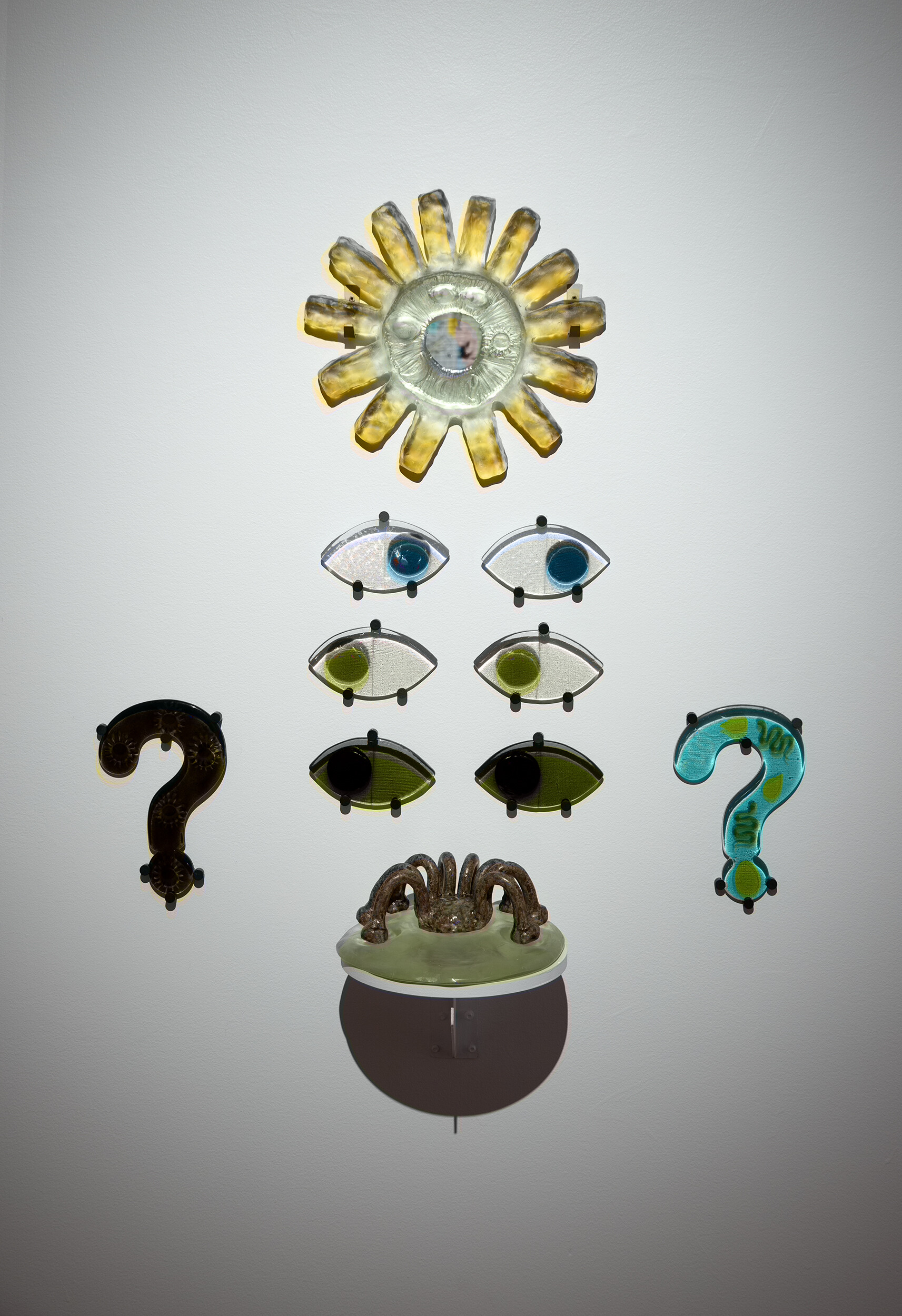
Installation view, Tamara Henderson Spider with the Glass Legs, 2025, The Warrnambool Art Gallery, photography David Keating
Henderson describes these broken-down concept/materials as Gardener, Director, Light, and Sound, which apparently come from experiments in her garden as well as earlier shows. Spider with the Glass Legs occupies the place of Light in this material menu. Henderson uses cinematic terminology to reflect on her practice, and perhaps this is what binds the networks together and connects her work. She says in her interview: “My practice is anchored by a consistent methodology of character building and energy translation.” The character here is Light, but it is also material glass. The immersive installation—full of symmetries and even spacing—can now be understood in cinematic terms: the repetition of objects can be the repetition of frames; the light through the glass becomes the light of the projector (I know I know: my metaphors about cinematic material are so twentieth-century vintage analogue, as is the old camera collection that I expend a lot of my own energy to stop from growing). Perhaps even light-refraction through glass can become lenses and optics? The idea of “energy translation” is also interesting: there are references throughout the interview to meditation, tantric energy, and other such woo. This stuff seems a little abstract to me, mostly because I’m not really that “into” that kind of thing. But when I think about these comments more, what they’re simply about is connection. How does one thought morph into another? Through the translation of energy. How does anything grow? Through the translation of energy. “Energy” can be thought of in these material terms, like the electricity in the lamps and the use of heat, air, and force to create glass.

Installation view, Tamara Henderson Spider with the Glass Legs, 2025, The Warrnambool Art Gallery, photography David Keating
Energy translation in connection to the more transcendent—at least notionally—practice of meditation can also be thought of as a way to channel mental focus and attention (“attention” being that thing in the last fifteen years or so that is both everywhere and nowhere). Our minds are based in a neuroplastic material, and our focus is a way to work that material, welding new pathways, melting new connections together. Some of these connections might be between ourselves and mystery kitchen utensils from long ago, or a particularly nice frying-pan rescued from hard rubbish, or our favourite plastic bag (we’ve actually been through a lot together). Both of these exhibitions approach the idea and fact of material with a deeply felt sense of connectedness, with a drive to make new connections. The trick is to know when there has been enough thinking and when to switch to making. Both Henderson and Varendorff approach this with intensity. For Varendorff, the small brass brackets carry the huge weight of a historically wrought position on social and economic labor. These material additions do a lot of lifting, literally and figuratively, and great focus is placed on the connections that emerge from this material construction. For Henderson, multiple thoughts are each named and given specific tasks and characters. This structure of practice allows the work to take on symbolism in a welcoming and fertile environment, and Henderson strikes a balance between allowing ideas in and controlling the flow from one character to the next. Ultimately, though, these artists show that making is a form of thinking, and thinking is a form of making.
David Wlazlo is an artist and writer who lives in Djilang/Geelong
